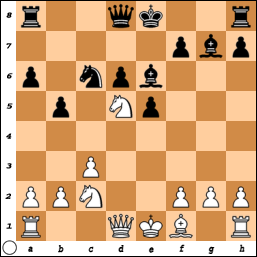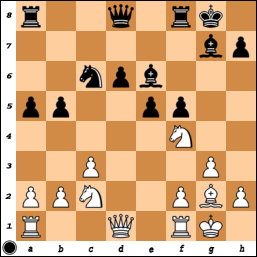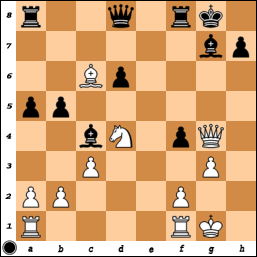The tournament was not a particular success for me, as I drew two games in the early rounds and then suffered a loss in the fifth round. In that game, I stubbornly refused to draw, pushing my luck in order to maintain contact to the table leaders. In the end, I ran into mate instead of giving perpetual check, thus effectively ending my bid for a prize rank.
Following this defeat, I set out to at least cut my losses in the remaining three rounds. Here, I was successful, scoring three quick wins, still taking a small prize and preserving my rating. In rounds 7 and 8 I had Black in two consecutive Sveshnikov Sicilians. I smashed my opponents up thoroughly.
Hannes Leisner (2182) - Oliver Uwira (2251)
Bad Harzburg Open 2011 (Round 8)
1. e4 c5 2. Nf3 Nc6 3. d4 cxd4 4. Nxd4 Nf6 5. Nc3 e5 6. Ndb5 d6 7. Bg5 a6 8. Na3 b5 9. Bxf6 gxf6 10. Nd5 f5 11. c3 Bg7 12. exf5 Bxf5 13. Nc2 Be6

So far, so good. This position was reached in both games. My opponent in round 7, however, didn't have a clue about how to deal with the 13..Be6 moveorder, which prevents White from playing Nce3 and Bd3. He had to learn that the hard way. Round 7 continued:
14. Nce3 Ne7 15. Nxe7? Qxe7 Black cannot prevent d6-d5 anymore after this. 16. Bd3 d5 17. Nf5 Qg5 18. Nxg7+ Qxg7 19. Qh5? Better is the exchange sacrifice 19. O-O e4 20. Bc2 Bh3 21. g3 Bxf1 22. Qxd5 O-O 23. Rxf1 Rfe8 where White has sufficient compensation. I probably wouldn't have taken the exchange. 19... e4 Also playable is 19... Qxg2 20. Qxe5 Qxh1+ 21. Kd2 Qxa1 22. Qxh8+ Ke7 23. Qxa8 Qxb2+ 24. Bc2 when White apparently does not have a perpetual check. Over the board, this was not clear enough to me and therefore I didn't take any chances. Even more so because my continuation is also almost winning. 20. Bf1 b4 21. Rc1 bxc3 22. bxc3 O-O 23. Qh4 Rfc8 24. Be2 Rxc3 Now White can't castle because Be6-h3 would win even more material. White is lost and the remainder of the game is agony. 25. Rd1 Rc2 26. Rg1 Rxa2 27. Qf4 Re8 28. Qe3 Ra1 29. f3 d4 30. Qd2 Rxd1+ 31. Bxd1 Bc4 32. Qb4 Bb5 33. Bb3 exf3+
34. Kf2 Re2+ 35. Kxf3 Qf6+ 36. Kg4 Re4+ 37. Kg3 Qf4+ 0-1
Back to round 8:
14. g3!
This is the best move, because it allows White to take with the bishop after 14...Ne7 15. Bg2 Nxd5? 16. Bxd5 with a clear advantage for White.
14...O-O 15. Bg2 a5 16. O-O f5 17. Nf4?!

After the game my opponent told me that his theoretical knowledge had been coming to an end around this point. The text move had caught his eye, and after some calculation, he considered it worth a try. I wasn't sure about the theory either, but I knew the antidote against stuff like this is usually: sacrifice and attack! Thus it didn't take me a lot of time to play:
17...exf4 18. Bxc6 fxg3 19. hxg3 f4! 20. Nd4?!
Even though the silicon brain likes 20. Bxa8, it would take balls of steel for White to play that over the board, as the Black compensation for the measly exchange looks massive. In fact, Houdini 1.5 evaluates the sequence 20. Bxa8 Qxa8 with only 0.18 in White's favour - which means I'm going to sacrifice three such exchanges before breakfast without even questioning my compensation.
The text move 20. Nd4, however, makes things very difficult for White. Best would have been 20. Bd5, which halves the dangerous bishop pair.
20...Bc4
The bot still wants to eat the exchange after 20...Bc4, but in my opinion, the lecture about compensation from the above paragraph still applies here. Apart from that, Black can force a perpetual check with 20...fxg3 - this was out of the question for me, of course, as I have already explained in the introduction.
21. Qg4

22...Ra7!
A cute move in typical Sveshnikov style. It rescues the rook and prepares its swing to g7, where it will brutally join Black's kingside attack. Moreover, White can't play 23. Ne6 because of 23...Qc8 and Black wins.
22. Rfd1?!
I have a lot of difficulties in pin-pointing the exact moment where White goes downhill. Houdini says that the position is still equal after 22. Bxb5 but I have to admit that this too complex for me to evaluate without analysing for hours.
All I know is that Black's game is much easier, because the attack plays itself in most variations and disaster lies in wait for White at the slightest inaccuracy.
22...Kh8 23. b3 Bxd4 24. Rxd4 Rg7 25. Qh3
During the game I thought the queen sacrifce 25. Qxg7+ Kxg7 26. bxc4 would offer White drawing chances. I had planned 26...b4! and the post-mortem confirmed that this move results in a definite Black advantage. The point is that White can't play 27. cxb4 because of the double attack Qb6 and therefore, Black will create a passed pawn at c3 which is too much for White to handle.
After the text move, the Black attack crashes through.
25...fxg3 26. f3 Qc7 27. bxc4
A nice finish is 27. Be4 Bxb3! 28. axb3 Qxc3 29. Rad1 Qe3+ 30. Kh1 g2+ 31. Kh2 Qf2 and Black wins.
27...Qxc6 28. Rf1 bxc4 29. f4 Qe8 0-1
White resigned because of 30. Rf3 g2 31. Rd1 Qe2 32. Ra1 Re8 and White can't prevent the loss of heavy material after 33...Qe1+.


No comments:
Post a Comment